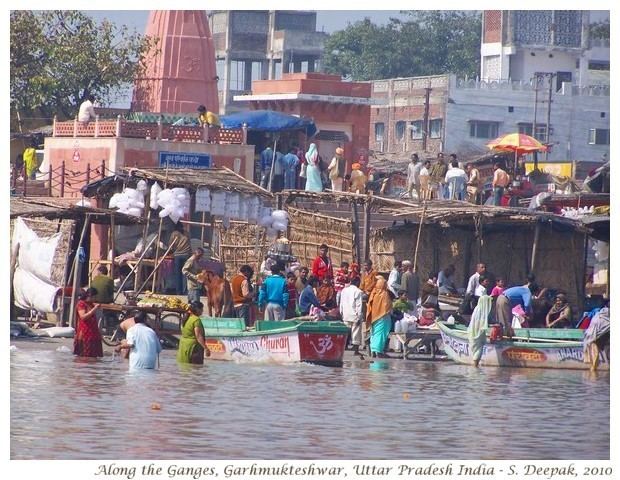Time zone IST (UTC+5:30) Area code 5731 | Named for Mukteshwar Mahadev PIN 245205 Local time Friday 11:17 PM | |
 | ||
Weather 16°C, Wind E at 8 km/h, 96% Humidity | ||
Garh ganga garhmukteshwar
Garhmukteshwar (also spelled Garhmukhteshwar) is a town and a municipal board in Hapur district in the state of Uttar Pradesh, India.
Contents
- Garh ganga garhmukteshwar
- Map of Garhmukteshwar Uttar Pradesh 245205
- Demographics
- Location
- History
- Anti Muslim violence
- Climate
- Attractions
- Railways
- References
Map of Garhmukteshwar, Uttar Pradesh 245205
Demographics
Garhmukteshwar had a population of almost 60000. Males constitute 54% of the population and females 46%. Garhmukteshwar has an average literacy rate of 82%, higher than the national average of 74%: male literacy is 88%, and female literacy is 76%. In Garhmukteshwar, 11% of the population is under 6 years of age.
Location
Garhmukteshwar is situated on the National Highway 24 joining New Delhi with Lucknow. The town is 5 kilometres (3.1 mi) from the Ganges River and around 100 kilometres (62 mi) from New Delhi, making it the closest major place of habitation to that river from India's capital city.
History
Garhmukteshwar is an ancient place that is mentioned in the Bhagavata Purana and the Mahabharata. It was a part of ancient Hastinapur, the capital of the Pandavas. An ancient fort, repaired by the Maratha leader Mir Bhawan, became, under the British, the headquarters of the tehsil. The name of the town is derived from the temple of Mukteshwar Mahadeva, dedicated to the goddess Ganga who is worshipped there in four temples. The town has 80 sati pillars, marking the spots where Hindu widows are said to have become satimata. The town also has a mosque, built by Gays-ud-din Balban, that bears an inscription in Arabic dating to 682 Hijri (1283 A.D.).
Anti-Muslim violence
Garhmukteshwar was the scene of major anti-Muslim violence in November 1946, at a time when various areas of British India were experiencing significant communal unrest as the partition of the country into India and Pakistan loomed. Gyanendra Pandey describes the place as "a metaphor for the atrocities of Partition; and Partition itself a metaphor for the kind of extraordinary genocidal violence that was not witnessed again in India, perhaps until 1984". A mela (fair) held 3 miles (4.8 km) from the town was attended by between 700,000 - 800,000 people and on 6 November 1946 there were a series of Hindu attacks on Muslim shopkeepers at the event, resulting in 46 deaths and a further 39 people injured. The assaults and also arson attacks continued on and off for several days at the mela, while the town of Garhmukteshwar itself witnessed a large number of anti-Muslim atrocities, including killings, arson and the destruction of the Muslim quarter. Official reports gave the Muslim death toll in the town as at least 214 people, and there were also some Hindu deaths in retaliatory attacks.
Official investigations into violence in Uttar Pradesh at that time note that there was a "desire for revenge" among both Hindus and Muslims, resulting from news of similar violence in Calcutta. Much of the violence was clearly organised in nature and the Rashtriya Swayamsevak Sangh, an extremist Hindutva organisation, was frequently blamed.
Climate
Garhmukteshwar has a monsoon influenced humid subtropical climate characterised by very hot summers and cool winters. Summers last from early April to late June during and are extremely hot, with temperatures reaching 43 °C (109 °F). The monsoon arrives in late June and continues till the middle of September. Temperatures drop slightly, with plenty of cloud cover but with higher humidity. Temperatures rise again in October and the town then has a mild, dry winter season from late October to the middle of March Lowest temperature recorded is 0.5 °C (32.9 °F). Rainfall is about 80 cm to 100 cm per annum, which is suitable for growing crops. Most of the rainfall is received during the monsoon. Humidity varies from 30 to 100%. The town receives no snow.
Attractions
Railways
There are two railways stations in the town, call Garhmukteshwar and Garhmukteshwar Bridge (Brijghat). They are on the Delhi-Moradabad line.
